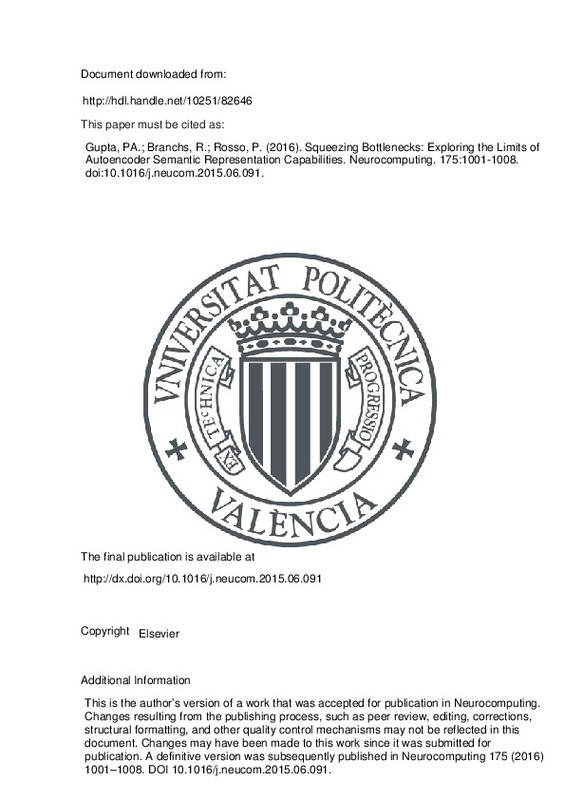JavaScript is disabled for your browser. Some features of this site may not work without it.
Buscar en RiuNet
Listar
Mi cuenta
Estadísticas
Ayuda RiuNet
Admin. UPV
Squeezing Bottlenecks: Exploring the Limits of Autoencoder Semantic Representation Capabilities
Mostrar el registro sencillo del ítem
Ficheros en el ítem
| dc.contributor.author | Gupta, Parth Alokkumar
|
es_ES |
| dc.contributor.author | Banchs, Rafael
|
es_ES |
| dc.contributor.author | Rosso, Paolo
|
es_ES |
| dc.date.accessioned | 2017-06-09T10:58:11Z | |
| dc.date.available | 2017-06-09T10:58:11Z | |
| dc.date.issued | 2016-01-29 | |
| dc.identifier.issn | 0925-2312 | |
| dc.identifier.uri | http://hdl.handle.net/10251/82646 | |
| dc.description | This is the author’s version of a work that was accepted for publication in Neurocomputing. Changes resulting from the publishing process, such as peer review, editing, corrections, structural formatting, and other quality control mechanisms may not be reflected in this document. Changes may have been made to this work since it was submitted for publication. A definitive version was subsequently published in Neurocomputing 175 (2016) 1001–1008. DOI 10.1016/j.neucom.2015.06.091. | es_ES |
| dc.description.abstract | [EN] We present a comprehensive study on the use of autoencoders for modelling text data, in which (differently from previous studies) we focus our attention on the various issues. We explore the suitability of two different models binary deep autencoders (bDA) and replicated-softmax deep autencoders (rsDA) for constructing deep autoencoders for text data at the sentence level. We propose and evaluate two novel metrics for better assessing the text-reconstruction capabilities of autoencoders. We propose an automatic method to find the critical bottleneck dimensionality for text representations (below which structural information is lost); and finally we conduct a comparative evaluation across different languages, exploring the regions of critical bottleneck dimensionality and its relationship to language perplexity. & 2015 Elsevier B.V. All rights reserved. | es_ES |
| dc.description.sponsorship | A significant part of this research work was conducted during the first author's attachment to the HLT department of I2R in Singapore. The work of the first and third authors was carried out in the framework of the WIQ-EI IRSES project (Grant no. 269180) within the FP 7 Marie Curie, the DIANA APPLICATIONS Finding Hidden Knowledge in Texts: Applications (TIN2012-38603-C02-01) project and the VLC/CAMPUS Microcluster on Multimodal Interaction in Intelligent Systems. | en_EN |
| dc.language | Inglés | es_ES |
| dc.publisher | Elsevier | es_ES |
| dc.relation.ispartof | Neurocomputing | es_ES |
| dc.rights | Reserva de todos los derechos | es_ES |
| dc.subject | Text representation | es_ES |
| dc.subject | Deep autoencoder | es_ES |
| dc.subject.classification | LENGUAJES Y SISTEMAS INFORMATICOS | es_ES |
| dc.title | Squeezing Bottlenecks: Exploring the Limits of Autoencoder Semantic Representation Capabilities | es_ES |
| dc.type | Artículo | es_ES |
| dc.identifier.doi | 10.1016/j.neucom.2015.06.091 | |
| dc.relation.projectID | info:eu-repo/grantAgreement/EC/FP7/269180/EU/Web Information Quality Evaluation Initiative/ | es_ES |
| dc.relation.projectID | info:eu-repo/grantAgreement/MINECO//TIN2012-38603-C02-01/ES/DIANA-APPLICATIONS: FINDING HIDDEN KNOWLEDGE IN TEXTS: APPLICATIONS/ | es_ES |
| dc.rights.accessRights | Abierto | es_ES |
| dc.contributor.affiliation | Universitat Politècnica de València. Escola Tècnica Superior d'Enginyeria Informàtica | es_ES |
| dc.description.bibliographicCitation | Gupta, PA.; Banchs, R.; Rosso, P. (2016). Squeezing Bottlenecks: Exploring the Limits of Autoencoder Semantic Representation Capabilities. Neurocomputing. 175:1001-1008. https://doi.org/10.1016/j.neucom.2015.06.091 | es_ES |
| dc.description.accrualMethod | S | es_ES |
| dc.relation.publisherversion | http://dx.doi.org/10.1016/j.neucom.2015.06.091 | es_ES |
| dc.description.upvformatpinicio | 1001 | es_ES |
| dc.description.upvformatpfin | 1008 | es_ES |
| dc.type.version | info:eu-repo/semantics/publishedVersion | es_ES |
| dc.description.volume | 175 | es_ES |
| dc.relation.senia | 326668 | es_ES |
| dc.contributor.funder | European Commission | |
| dc.contributor.funder | Ministerio de Economía y Competitividad | es_ES |







![[Cerrado]](/themes/UPV/images/candado.png)

